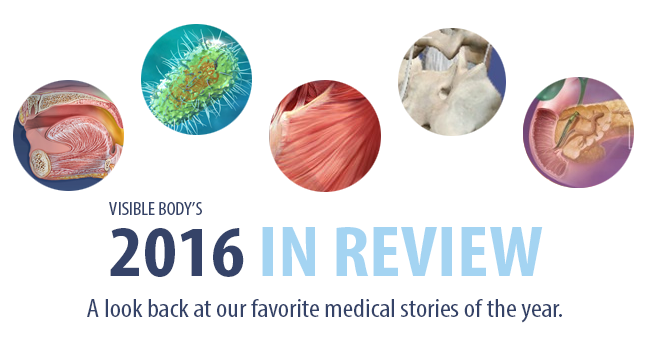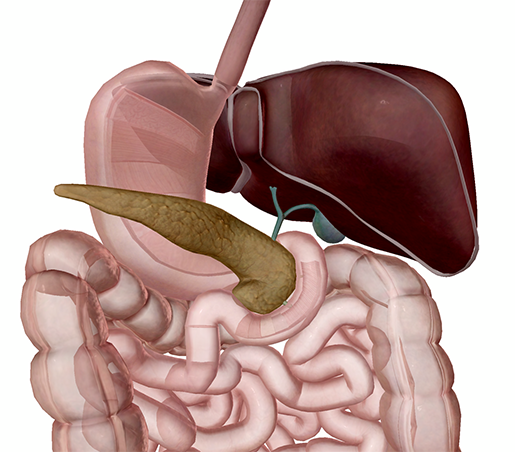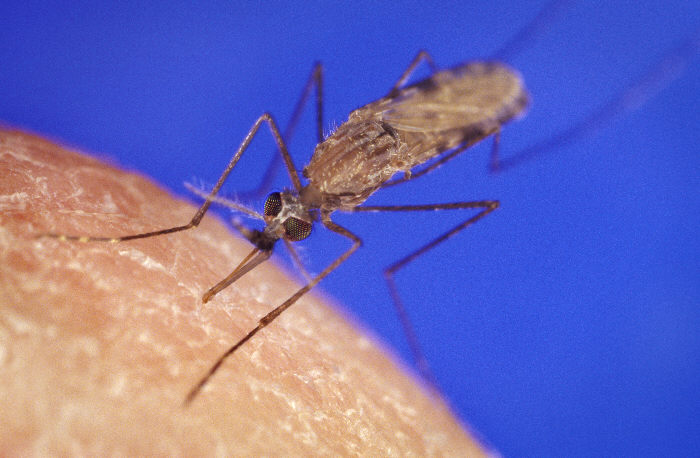Year-End Roundup: The Seven Coolest Medical Stories of 2016
Posted on 12/30/16 by Courtney Smith

Well, here we are again in the final stretch of the year. Hard to believe 2016 is over, huh? Although I won't be sad to say goodbye to it—Carrie Fisher, Debbie Reynolds, and George Michael, all in less than a week? 2016 had no chill.
Despite the fact that this year's Oscar In Memoriam segment is going to be 45 minutes long, 2016 also had its bright moments: it had some of the wackiest, most incredible happenings in the world of medicine.
Let's take a look at some of 2016's coolest medical stories:
YOU WOT, MATE?
Texan woman wakes up from surgery with a British accent!
Why not kick off with my favorite story from this year, which involved a woman undergoing surgery and waking up with an accent that wasn't the one she had when she went under. When I first read this back in June, I was skeptical. If anything, this woman had to be pulling a Madonna, right?
Wrong.
When she had surgery to correct her overbite, Lisa Alamia, a born-and-bred American, came out of it speaking with a completely different accent—a British one. Well, sort of. She woke up with the incredibly rare condition known as Foreign Accent Syndrome. There are only 100 known cases of it, with most resulting from neurological damage or head trauma, although Alamia's scans and tests have all come back clear.
FAS occurs when the part of the brain that deals with the actual vocals of speech (cadence, melody, rhythm, etc.) is damaged, and speech is altered in terms of timing, intonation, and tongue placement so that is perceived as sounding foreign, resulting in a new "accent." It's important to note that Alamia isn't technically speaking with a British accent; the cadence of her speech has changed to sound like it (especially to Americans like me).
According to the University of Texas at Dallas, FAS has been documented in cases around the world, including accent changes from Japanese to Korean, British English to French, American-English to British English, and Spanish to Hungarian.
So while Lisa Alamia might not be firing up the tea kettle and having bangers and mash on the regular, her new "accent" is still super cool.
BYE BYE, DIALYSIS!
The rise of the artificial kidney.
Way back toward the start of the year, a tiny Windows logo wannabe came out of Vanderbilt University in Tennessee and told the world we were approaching the day when dialysis would be a thing of the past.
Using silicon nanotech, Vanderbilt University Medical Center’s Dr. William Fissell and his team have created a filter chip that will, with the help of living kidney cells, mimic the functionality of a healthy kidney. The promised result is that it'll be about the size of a natural kidney and will be powered by the body's own blood flow.
What's incredible about this little filter is the aforementioned kidney cells, which do things like nutrient reabsorption and getting rid of accumulated waste—something that synthetic components aren't good at.
Wanna learn more about it? Check it out here!
EASY THERE, AUGUSTUS GLOOP:
Consuming chocolate daily can lower your risk for
diabetes and heart disease.
It seems almost too good to be true. Chocolate is, after all, a sugar and high fat bomb that can cause obesity and tooth decay (or an allergic reaction in my case, womp womp), so how can it be possible that eating chocolate on the reg can yield such happy results? Well, it seems through more and more focused study that moderate consumption of the confection—particularly dark chocolate—is a good thing!
I've singled out dark chocolate because it has the highest cocoa content, which means it has the highest levels of antioxidants—flavonoids, which are molecules that can prevent some forms of cell damage.
Prof. Saverio Stranges of the University of Warwick Medical School, United Kingdom and the Department of Population Health at the Luxembourg Institute of Health (LIH) and his colleagues ran the Observation of Cardiovascular Risk in Luxembourg (ORISCAV-LUX) study, which took a look at the chocolate consumption of 1,153 people between the ages of 18 and 69. The purpose of the study was to investigate whether chocolate intake is associated with insulin resistance (where the body's cells do not effectively respond to insulin, raising the risk for type 2 diabetes and heart disease), as well as how chocolate consumption affected liver enzyme levels (a measure of liver function).
 Image captured from Human Anatomy Atlas.
Image captured from Human Anatomy Atlas.
Of the participants, 81.8 percent consumed chocolate, with an average consumption of 24.8 grams daily. Compared with the participants who didn't eat chocolate, those who did had reduced insulin resistance and improved liver enzyme levels. And the more chocolate consumed, the stronger the effect.
The team published their results of their study in the British Journal of Nutrition.
So continue eating that chocolate, you chocoholics! But, you know, keep exercising and brushing your teeth too.
SMILE!
A special liquid is fighting the good fight against cavities.
And right on the heels of the chocolate story...
I have to admit, I've never had a cavity in my life. I'm a freak when it comes to my teeth. My most prized possession in my bag isn't my wallet, but my giant thing of dental floss, which gets used at least 5 times a day. But while I might be super vigilant about my teeth, there are plenty of those who aren't. I had friends in grade school who practically lived at the dentist's.
But cavities may be fighting a losing battle with the advent of silver diamine fluoride, or SDF. This special liquid has been in use for decades in Japan but has only recently been introduced to the States. Used as a desensitizer for adults, studies have shown that it can halt the progression of cavities and even prevent them altogether!
SDF is a microbial liquid that is painlessly brushed onto the teeth in less than a minute—no drills, no mess.
While SDF has an amazing effect on cavities, the same can't be said for what it does to the aesthetic of a tooth, or a patient's wallet. SDF darkens the brownish decay on a tooth, which can be unsightly for some and not worth the risk. Not to mention that until more insurers hop on the bandwagon, it's an out-of-pocket expense. Relatively cheap one, though, clocking in at $25 per treatment.
So, if you're prone to cavities and want to ditch the drill, you've got options!
SEE YA LATER, LEUKEMIA:
New blood cancer treatment shows "unprecedented" preliminary results
Okay, now we need to take this with some caution, as the findings haven't been published in a peer-reviewed journal yet, but Dr. Stanley Riddell, an immunotherapy researcher and oncologist at Seattle's Fred Hutchinson Cancer Research Center, presented new adoptive T-cell strategies for cancer at the annual meeting of the American Association for the Advancement of Science in Washington, D.C. on February 14th.
One of the new strategies is a therapy that uses white T-cells as, well, attack dogs. White blood cells are extracted from terminally ill cancer patients and then genetically reprogrammed to target cancer cells. The souped-up cells are then reintroduced into a patient’s bloodstream, where they make it much harder for the cancer to spread and take hold.
Riddell and his colleagues have seen "sustained regression" in many relapsing and treatment-resistant cases of B-cell malignancies: acute lymphoblastic leukemia, Non-Hodgkin lymphoma and chronic lymphocytic leukemia.
In one trial, 94 percent of terminally ill lymphoblastic leukemia patients went into remission, while patients with similar blood cancers experienced response rates greater than 80 percent, with more than half going into remission.
In November of this year, Riddell received the American Cancer Society research professorship to continue his immunotherapy research.
TASTES LIKE CHICKEN:
Changing the way humans "taste" to mosquitos
could help fight Malaria.
Mosquitos are the absolute worst—like, why are they even here? All they do is suck your blood and kill over 750,000 people a year. That's not an exaggerated number, either. Mosquitos are the deadliest animals on the planet, with their bite transmitting countless diseases. Mosquito-borne Malaria alone kills 600,000 every year. If humans didn't taste so damn good to mosquitos, think of how many lives could be saved.
Well, we're working on it. And by "we" I mean "researchers at Johns Hopkins."
They posit that because mosquitos use a bunch of different senses (smell, temperature, and sight, among others) to detect their next human host, identifying a substance that makes the taste of humans "repulsive" to the Anopheles gambiae, or malaria mosquito, could stop the transmission of the disease.
 What a jerk. (J. Gathany / Public Health Image Library)
What a jerk. (J. Gathany / Public Health Image Library)
"Our goal is to let the mosquitoes tell us what smells they find repulsive and use those to keep them from biting us," said Christopher Potter, Ph.D., assistant professor of neuroscience at the Johns Hopkins University School of Medicine.
The team isolated a special area of the mosquito brain to see where olfactory neurons went using a powerful genetic technique—never before accomplished in mosquitoes, according to Potter—to make certain neurons "glow" green. The green glowing label was designed to appear specifically in neurons that receive complex odors through proteins called odorant receptors (ORs), since OR neurons are known to help distinguish humans from other warm-blooded animals in Aedes aegypti mosquitoes, which carry the Zika virus.
“We’d like to figure out what regions and neurons in the brain lead to this combined effect,” said Potter. “If we can identify them, perhaps we could also stop them from working.”
SOMETHING FISHY IN THE STATE OF DENMARK:
Pregnant women who take fish oil pills lower their child's
risk of having Asthma.
And last but not least on our list is an interesting study out of Denmark that found pregnant women who took fish oil pills in the later stages of their pregnancies saw lower rates of Asthma in their children. The study randomly assigned 736 pregnant women at 24 weeks of gestation, and a total of 695 children were born and 95.5% completed the 3-year, double-blind follow-up period.
Among children whose mothers took fish-oil capsules, 16.9 percent had asthma by age 3, compared with 23.7 percent whose mothers were given placebos. The difference is a risk reduction of about 31 percent. Pretty significant, right?
Well, pump the breaks before any of you pregnant readers rush out to the nearest vitamin store.
The author of the study, Dr. Hans Bisgaard, professor of pediatrics at the University of Copenhagen and the head of research at the Copenhagen Prospective Studies on Asthma in Childhood, says he isn't ready to recommend that pregnant women routinely take fish oil. While the study found no adverse effects in the mothers or babies, the doses were super high: 2.4 grams per day—15 to 20 times what most Americans consume from foods.
According to the Centers for Disease Control and Prevention (CDC), asthma has more than doubled in developed countries in recent decades. More than six million children in the United States have it, as do more than 330 million children and adults worldwide.
Previous research had suggested that fish oil might help prevent asthma. Since inflammation in the airways and lungs plays a major role in asthma, and fatty acids in fish oil are thought to prevent inflammation, it seems like a no-brainer. We'll have to wait and see what further studies determine.
*****
From everyone at Visible Body, we hope you had a wonderful year with us, and we look forward to bringing you more anatomy goodness in 2017.
Happy New Year!
Be sure to subscribe to the Visible Body Blog for more anatomy awesomeness!
Are you a professor (or know someone who is)? We have awesome visuals and resources for your anatomy and physiology course! Learn more here.



